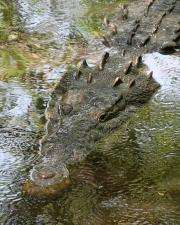November 30, 2012 report
Researchers find scales on crocodile heads are formed from cracks not genetically defined

(Phys.org)—A research team made up of members from Switzerland, France and Belgium has discovered that the scales on the heads of crocodiles are not arranged due to genetics but come about because of cracking in the skin while the skull is still developing. They describe their research and findings in their paper published in the journal Science.
Scale development in reptiles, the team notes generally comes about due to a process known as scale primordium, where units of development are genetically driven – scales grow in the shape and color that have been described by their DNA. That's the case for crocodiles as well, they write, except for the scales that cover the head, where things are very different. Instead of regular patterns that occur due to scale primordium, there is chaos the researchers found, which led them to wonder if a different development process was at work.
To find out, they took multiple high resolution photographs of the heads of 15 young crocodiles from every angle possible then used computer software to create 3D models made up of just the lines that formed the divisions between the scales. The lines were then analyzed using pattern recognition software and the results showed that the polygons that were created by the lines mimicked patterns seen in natural cracking, such as when mud dries or a pot is broken.
Next, the team studied embryonic development of crocodiles in their lab, watching closely as Dermal Pressure Sensors (DPS) – sensory organs that detect surface water changes – developed as raised bumps or mounds in random fashion over the face, jaws and other parts of the head. Scale primordium never occurred. Instead thick skin developed over and around the DPS bumps. As the skull grew, grooves began to appear between the mounds that eventually became interconnected. As the grooves deepened they began to take on the familiar look of the adult resulting in the scaly look that crocodiles are known for.
This discovery, the researchers say, provides more information to scientists studying the interplay between genetic determination and the physical and/or chemical processes in the environment that together determine the biologic development of organisms.
More information: Crocodile Head Scales Are Not Developmental Units But Emerge from Physical Cracking, Science, DOI: 10.1126/science.1226265
ABSTRACT
Various lineages of amniotes display keratinized skin appendages (feathers, hairs, and scales) that differentiate in the embryo from genetically controlled developmental units whose spatial organization is patterned by reaction-diffusion mechanisms (RDM). We show that contrary to skin appendages in other amniotes (as well as body scales in crocodiles), face and jaws scales of crocodiles are random polygonal domains of highly keratinized skin, rather than genetically controlled elements, and emerge from a physical self-organizing stochastic process distinct from RDM: cracking of the developing skin in a stress field. We suggest that the rapid growth of the crocodile embryonic facial and jaw skeleton, combined with the development of a very keratinized skin, generates the mechanical stress that causes cracking.
Journal information: Science
© 2012 Phys.org



















